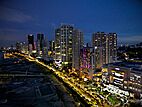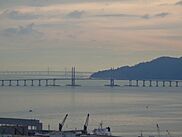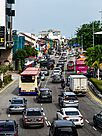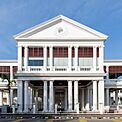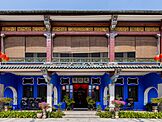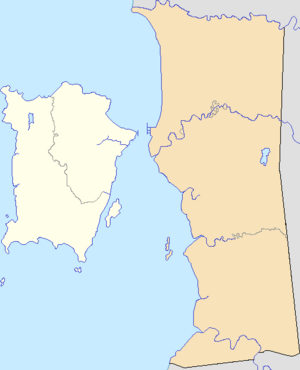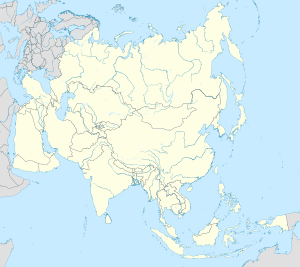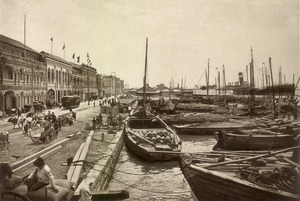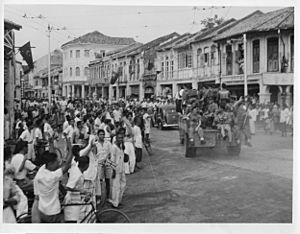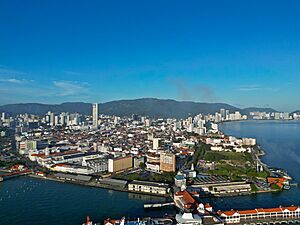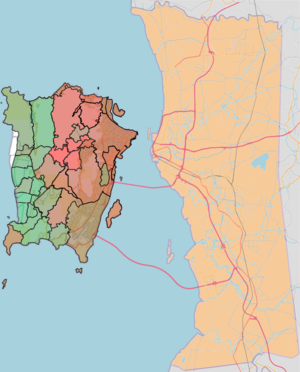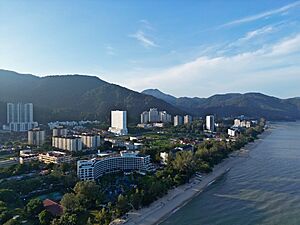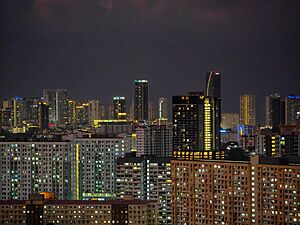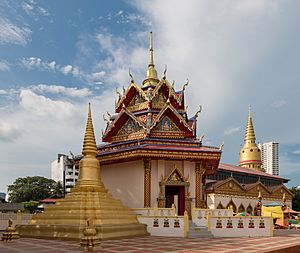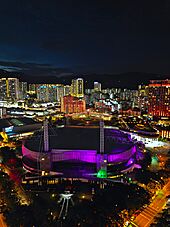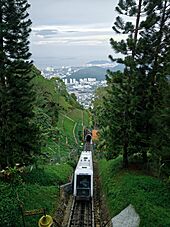George Town, Penang facts for kids
Quick facts for kids
George Town
Bandaraya Pulau Pinang
|
|||||||||||||
|---|---|---|---|---|---|---|---|---|---|---|---|---|---|
|
State capital city and district capital
|
|||||||||||||
| City of Penang Island | |||||||||||||
| Other transcription(s) | |||||||||||||
| • Mandarin |
|
||||||||||||
| • Hokkien | Pho-té / Kiâu-tī-tshī (Tâi-lô) | ||||||||||||
| • Tamil | ஜார்ஜ் டவுன் Jārj Iḍavuṉ (Transliteration) | ||||||||||||
| • Thai | จอร์จทาวน์ Chogethao (RTGS) | ||||||||||||
|
Skyline of the city centre
Gurney Drive
The two Penang bridges
Penang Road
Penang High Court
Cheong Fatt Tze Mansion
Komtar
Khoo Kongsi
|
|||||||||||||
|
|||||||||||||
| Etymology: George III, King of Great Britain and Ireland | |||||||||||||
| Nickname(s):
Pearl of the Orient
|
|||||||||||||
| Motto(s):
Leading We Serve
(Malay: Memimpin Sambil Berkhidmat)
|
|||||||||||||
| Country | |||||||||||||
| State | |||||||||||||
| Districts | Northeast and Southwest | ||||||||||||
| Mukims | City centre and 36 subdistricts | ||||||||||||
| Founded | 11 August 1786 | ||||||||||||
| Municipality | c. 1857 | ||||||||||||
| Incorporated (city) | 1 January 1957 | ||||||||||||
| Expansion | 31 March 2015 | ||||||||||||
| Founded by | Francis Light | ||||||||||||
| Government | |||||||||||||
| • Type | City council | ||||||||||||
| • Body | Penang Island City Council | ||||||||||||
| Area | |||||||||||||
| • City | 306 km2 (118 sq mi) | ||||||||||||
| • Metro | 3,759 km2 (1,451 sq mi) | ||||||||||||
| Population
(2020)
|
|||||||||||||
| • City | 794,313 | ||||||||||||
| • Rank |
|
||||||||||||
| • Density | 2,596/km2 (6,720/sq mi) | ||||||||||||
| • Metro | 2,844,214 (2nd) | ||||||||||||
| • Metro density | 760/km2 (2,000/sq mi) | ||||||||||||
| Demonym(s) | Georgetowner | ||||||||||||
| Demographics | |||||||||||||
| • Ethnic groups | |||||||||||||
| Time zone | UTC+8 (MST) | ||||||||||||
| • Summer (DST) | Not observed | ||||||||||||
| Postal code |
|
||||||||||||
| Area code(s) | 4-2, 4-6, 4-8 | ||||||||||||
|
|||||||||||||
George Town is the capital city of Penang, a state in Malaysia. It's a very important city for business in northern Malaysia. George Town is also known as the "Pearl of the Orient" because of its beauty.
The city is famous for its unique buildings and mix of cultures. People from many different backgrounds have lived here for centuries. This rich history and culture helped the city center of George Town become a UNESCO World Heritage Site in 2008. George Town is also known as Malaysia's food capital, with lots of delicious local dishes.
Contents
- What's in a Name?
- A Look Back: George Town's History
- George Town's Location and Landscape
- Who Lives in George Town?
- George Town's Economy
- City's Look and Feel
- George Town's Culture
- Learning in George Town
- Healthcare Services
- Media and Entertainment
- Getting Around George Town
- City Services
- International Connections
- Famous People from George Town
- See also
What's in a Name?
George Town was named after George III. He was the King of Great Britain and Ireland from 1760 to 1820.
Before the British arrived, the area was called Tanjung Penaga. This name came from the many penaga laut trees found there. Tanjung means cape in Malay.
Sometimes, people mistakenly spell the city's name as "Georgetown". However, "George Town" (two words) is the correct official name.
A Look Back: George Town's History
 British East India Company 1786–1858
British East India Company 1786–1858 British Raj 1858–1867
British Raj 1858–1867 Straits Settlements 1826–1941; 1945–1946
Straits Settlements 1826–1941; 1945–1946 Empire of Japan 1941–1945
Empire of Japan 1941–1945 Malayan Union 1946–1948
Malayan Union 1946–1948 Federation of Malaya 1948–1963
Federation of Malaya 1948–1963 Malaysia 1963–present
Malaysia 1963–present
How George Town Started
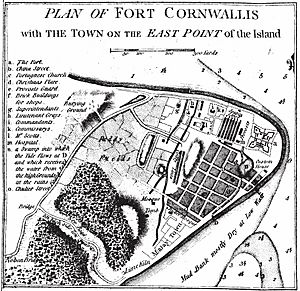
In 1771, a former navy captain named Francis Light was sent by the East India Company (EIC). His job was to set up trade in the Malay Peninsula. The ruler of Kedah, Sultan Muhammad Jiwa Zainal Adilin II, offered Light Penang Island. In return, he wanted British military protection.
Light saw that the island was a great place for trade. He thought it could help the British control trade in Southeast Asia. In 1786, Light was finally allowed to get Penang Island for the British. He landed on the island on July 17 and officially claimed it for George III on August 11. Penang Island was renamed Prince of Wales Island. George Town became the first British colony in Southeast Asia.
When Light first arrived, the area was thick jungle. After clearing it, Light built Fort Cornwallis. This was the first building in the new settlement. The first roads in George Town were Light, Beach, Chulia and Pitt streets. They were built in a grid pattern. This made it easy to divide land and move troops.
Under British Rule
George Town quickly grew as a free port. It became a major center for the spice trade. This trade helped the EIC pay for running Penang. To protect against French invasion during the Napoleonic Wars, Fort Cornwallis was made stronger.
In 1807, a special law called the Charter of Justice was passed. This led to the creation of a "Court of Judicature". George Town became the first place in British Malaya with a modern court system.
In 1826, George Town became the capital of the Straits Settlements. This group also included Singapore and Malacca. But in 1832, Singapore became more important for trade. So, the capital moved there. Even so, George Town remained a key British trading post.
After the Suez Canal opened in 1869, and with a boom in tin mining, the Port of Penang became a top tin exporter. By the late 1800s, George Town was the main financial hub of British Malaya. Many international banks opened here.
George Town's population grew fast with its economic success. People from all over Asia moved here. This created a diverse population of Chinese, Malays, Indians, Peranakans, and Eurasians.
In 1867, George Town came under direct British rule. Law enforcement improved, and more money was spent on healthcare and public transport. George Town also became a place for thinkers and political leaders. Famous people like Rudyard Kipling and Sun Yat-sen visited. Sun Yat-sen even used George Town as a base for his revolutionary activities against China's Qing dynasty.
World Wars and Changes
George Town was mostly safe during World War I. But World War II brought big changes. In December 1941, Japanese planes bombed the city. Many people fled. The British leaders decided to leave the island and secretly move Europeans away. This left Asian residents unprotected.
The Imperial Japanese Army took George Town on December 19 without a fight. During the Japanese occupation, the Japanese used Swettenham Pier as a submarine base. Japanese military police were very strict. They killed many Chinese civilians.
From 1944 to 1945, Allied planes bombed George Town. They targeted military buildings, damaging many colonial structures. After Japan surrendered, British Royal Marines took back George Town on September 3, 1945. It was the first place in British Malaya to be freed.
After Independence
After the war, the British ended the Straits Settlements. Penang became part of the Malayan Union in 1946. Many people in Penang were worried. They feared George Town would lose its free port status. A group called the Penang Secessionist Committee tried to stop Penang from joining Malaya.
However, the British government promised to keep George Town's free port status. They also promised more local control. In 1956, George Town became Malaya's first fully-elected municipality. The next year, Queen Elizabeth II made it a city. This made George Town the first city in the new country of Malaya.
Modern George Town
In the early years of Malaysia's independence, George Town kept its free port status. The city council had a lot of money. It was the richest local government in Malaysia by 1965. This allowed them to build public housing and the Ayer Itam Dam.
However, political disagreements led to the city council's powers being taken over in 1966. Local elections were also stopped nationwide. In 1969, the Malaysian government removed George Town's free port status. This caused many people to lose their jobs and led to the city's decline.
To help Penang recover, Chief Minister Lim Chong Eu started the Komtar project in 1974. He also created the Bayan Lepas Free Industrial Zone (FIZ). These efforts helped Penang's economy grow. However, they also caused people to move to newer areas outside the city center.
In 1974, George Town merged with the rest of Penang Island. This caused confusion about its city status. But in 2015, George Town's city status was fully restored and expanded to cover the entire island.
A City Reborn
At the end of the 20th century, George Town saw a real estate boom. But in 2001, a law that protected old buildings was removed. This caused many historic buildings to fall into disrepair. The city also faced problems with traffic and urban planning.
In response, local groups worked together to save the historic buildings. Their efforts led to the city center becoming a UNESCO World Heritage Site in 2008. This helped George Town's economy grow again. The city has seen a boost in its private sector.
George Town's city area was expanded in 2015. It now includes all of Penang Island and nearby small islands. This helped better protect the city's heritage.
George Town's Location and Landscape
George Town covers about 306 square kilometers. This includes all of Penang Island and nine smaller islands nearby. Penang Island has mountains in the middle and narrow coastal areas. The city center is on the northeastern tip.
Over time, George Town has grown along the northern coast, south along the eastern shore, and towards Penang Hill in the west. The surrounding islands include Jerejak, Andaman, and Tikus. The Pinang River flows through the city center.
Penang Hill is the highest point in Penang. It helps collect water and provides a green space for the city. In 2021, the Penang Hill Biosphere Reserve became a UNESCO Biosphere Reserve. This recognized its amazing variety of plants and animals.
Because land is scarce, George Town has created new land by filling in parts of the sea. This is called land reclamation. Areas like Tanjong Tokong and Bayan Lepas have expanded this way. A big project called Silicon Island is being built on reclaimed land. It will be a new center for high-tech businesses.
George Town's Weather
George Town has a tropical rainforest climate. This means it's warm and humid all year round. The average high temperature is about 32°C, and the average low is 24°C. The city gets about 2477 mm of rain each year.
Sometimes, George Town can experience haze. This happens when wind carries dust from forest fires on the nearby island of Sumatra.
Who Lives in George Town?
| Ethnicities of George Town in 2020 | ||||
|---|---|---|---|---|
| Ethnicities / Nationality | Percentage | |||
| Chinese | 51.2% | |||
| Malays | 30.7% | |||
| Other Bumiputeras | 0.6% | |||
| Indians | 8.2% | |||
| Others | 0.8% | |||
| Non-Malaysians | 8.5% | |||
In 2020, George Town had a population of 794,313 people. About 20% of them lived in the city center. George Town is one of the most crowded cities in Malaysia. The city's identity comes from centuries of different cultures mixing together. The larger George Town area, including nearby places, has over 2.8 million residents. This makes it the second largest metropolitan area in Malaysia.
Different Ethnic Groups
Historically, George Town has had a large Chinese population. In 2020, Chinese people made up more than half of the city's residents.
During British rule, Chinese people were grouped by their dialects, like Hokkien and Cantonese. The Peranakan Chinese were an important group. They were descendants of mixed Malay and Chinese families. They often preferred Western education and held important positions. Their culture is still strong in the city, seen in buildings and food like asam laksa.
Bumiputeras include ethnic Malays and native groups from East Malaysia. They made up about 31% of the city's population in 2020. Many people from Sabah and Sarawak have moved to George Town for jobs. Ethnic Indians make up another 8% of the population. There are also smaller groups like Eurasians and Siamese.
About 8.5% of the city's population are not Malaysian citizens. George Town is popular with people from other countries. This is because of its affordable living costs, beautiful places, good healthcare, and the common use of English. News outlets have even called it one of the best cities for retirement.
In the past, George Town attracted many other communities. These included Burmese, Acehnese, Arabs, and Japanese. While most of these groups are gone, they left behind landmarks and street names.
Languages Spoken
George Town is a multilingual city. The main languages spoken are Malay, English, Hokkien, Mandarin, and Tamil. Penang Hokkien, a local version of the Hokkien dialect, is often used as a common language between different ethnic groups.
During British rule, English was the official language. It was used in schools. This led to groups of English-speaking Chinese and Indian people.
Today, Malay is Penang's official language. Malays and Jawi Peranakans often use Bahasa Tanjong, a local Malay dialect. Tamils are the largest Indian group, and Tamil is used in their primary schools. Other Indian languages like Telugu and Punjabi are also spoken.
The Chinese community speaks various dialects, including Teochew and Cantonese. Mandarin is taught in Chinese schools. Penang Hokkien has borrowed words from Malay and English. While still widely spoken, its use is decreasing as Mandarin and English become more common.
In 2008, new bilingual street signs were put up in George Town. These signs show street names in Malay, English, Chinese, Tamil, or Arabic. This highlights the city's diverse language character.
George Town's Economy
George Town is the capital of Penang, one of Malaysia's four high-income areas. The city's economy is diverse. It relies on manufacturing and services. Key industries include electronics, optical manufacturing, hospitality, trade, logistics, finance, and real estate.
George Town is home to over 300 multinational companies (MNCs). This strong manufacturing sector has made George Town Malaysia's top exporter. It's also a major place for foreign direct investment (FDI). The George Town area has the second largest economy in Malaysia.
Experts say George Town has the best potential for revenue growth among Malaysian cities. It was also ranked as Malaysia's most attractive place for commercial property investment in 2016. George Town is considered a "Gamma −" level global city. This is because of its strong finance and insurance services.
Manufacturing in George Town

After George Town lost its free port status in 1969, Chief Minister Lim Chong Eu worked to boost Penang's economy. He started the Bayan Lepas Free Industrial Zone (FIZ) in 1972. This zone has been very important for Penang's economic growth.
The Bayan Lepas FIZ is known as the Silicon Valley of the East. It has over 300 multinational companies. These include tech giants like AMD, Bosch, HP Inc., and Intel.
This strong electronics industry has made George Town a top spot for foreign investment. It is also Malaysia's leading exporter. In 2021, Penang received RM74.4 billion in foreign investment, with the Bayan Lepas FIZ contributing over 95%. The Penang International Airport (PIA), next to the zone, handled RM385 billion worth of exports in 2022. This made it the largest exporter among all Malaysian ports.
Financial Services
George Town was once the financial center of British Malaya. Many international banks like Standard Chartered and HSBC opened branches here in the late 1800s. Today, George Town remains the financial hub of northern Malaysia.
The city has a special area called the George Town Central Business District (CBD). This area is for finance and banking. It includes Beach Street, Northam Road, and Pulau Tikus. Federal financial institutions like Bank Negara are also located here. In 2022, finance and related services contributed 9.1% to Penang's economy.
Tourism and Other Services
George Town has always been a popular tourist spot in Malaysia. It attracts visitors with its architecture, diverse cultures, beautiful beaches, hills, and amazing food.
Tourists can arrive by air at Penang International Airport (PIA) or by sea at Swettenham Pier. Swettenham Pier is Malaysia's busiest port for cruise ships. PIA is also the third busiest airport in the country for passengers.
George Town is growing its tourism to include healthcare tourism and business events. The city has several private hospitals. This makes Penang a top place for medical tourists in Malaysia. George Town is also the second most popular place in Malaysia for meetings and conferences.
The city has many shopping malls like Gurney Plaza and Queensbay Mall. Traditional shops and markets also thrive. They offer unique local products like nutmegs and Tambun biscuits.
In 2004, the Bayan Lepas FIZ became a "Multimedia Super Corridor Cyber City". This helped George Town become a hub for shared services and outsourcing (SSO). By 2016, Penang attracted the second largest share of investments for global business services in Malaysia. This created over 8,000 high-income jobs.
City's Look and Feel
George Town's Architecture
In 2008, UNESCO named about 260 hectares of George Town's city center a World Heritage Site. This area is special because of its "unique architectural and cultural townscape". It's a mix of British-era buildings and various Asian styles.
The city center has 3,642 heritage buildings. You can see shophouses, Anglo-Indian bungalows, mosques, temples, and churches. Famous landmarks include the Khoo Kongsi, Kapitan Keling Mosque, and Sri Mahamariamman Temple. Siamese and Burmese influences are seen in places like Wat Chayamangkalaram and Dhammikarama Burmese Temple.
Besides old buildings, George Town also has many skyscrapers. The tallest ones include the Komtar Tower and Marriott Residences. There's a growing demand for high-rise homes in the suburbs.
Parks and Green Spaces
The Penang Botanic Gardens opened in 1884. It was Malaysia's first botanical garden. It's used for plant research and protecting wildlife. This garden is part of the Penang Hill Biosphere Reserve, a UNESCO site. Nearby, the City Park opened in 1972 for public recreation.
The Penang National Park covers 2562 hectares. It has coastal hills, lakes, mangroves, and beaches where turtles nest. This park is a key eco-tourism spot.
Gurney Bay is a new park being built on reclaimed land. It will have food areas, water gardens, a man-made beach, and a coastal grove. The first part of Gurney Bay opened in 2024.
The Penang Island City Council is also creating 18000 hectares of connected parks and waterways. This project aims to make George Town greener and fight climate change. It includes coastal parks and "blue corridors" along rivers.
George Town's Culture
Arts and Creativity
The Chingay procession in George Town started in 1919. It's famous for people balancing huge flags on their heads. Today, Chingay parades are held yearly as a tourist attraction. They are a big part of the Penang Chinese identity.
George Town is also where Bangsawan theater began. This Malay theater mixes Indian, Western, Islamic, Chinese, and Indonesian styles. Boria, another unique theater form with singing and music, also started here.
George Town has become a center for arts and culture in Malaysia. The George Town Festival is a major yearly arts event in Southeast Asia. The George Town Literary Festival won an international award in 2018.
In 2012, artist Ernest Zacharevic created murals showing local life. The city also has 52 iron caricatures and 18 wall murals. These tell stories about George Town's history and daily life. Art exhibitions are held at places like the Hin Bus Depot.
Delicious Food Scene
George Town is famous for its food. It mixes Malay, Chinese, Indian, Peranakan, and Thai influences. You can find amazing street food like char kway teow, asam laksa, and nasi kandar.
CNN called George Town "the food capital of Malaysia". Time and Lonely Planet also listed it as one of Asia's best cities for street food. They noted how good and cheap the food is.
The city's food scene now includes fine dining restaurants too. In 2022, the Michelin Guide started featuring restaurants in Penang. The 2024 guide lists 53 eateries in George Town.
Sports and Events
George Town has many sports facilities. The City Stadium is home to Penang FC. The SPICE Arena has an indoor arena and a swimming center. Malaysia's oldest horse riding center, the Penang Turf Club, is also here.
The city has hosted big sports events like the 2001 SEA Games. Annual events include the Penang International Dragon Boat Festival and the Penang Bridge International Marathon. The Dragon Boat Festival attracts international participants every December. The marathon, which crosses the Penang Bridge, had about 20,000 runners in 2023.
Learning in George Town
As of 2022[update], George Town has 111 primary schools and 49 secondary schools. Many mission schools were built during British rule, like St. Xavier's Institution and St. George's Girls' School. Penang Free School (PFS), founded in 1816, is the oldest English school in Southeast Asia.
The first Chinese school in George Town opened in 1819. This marked the start of modern Chinese education in Malaysia. The Penang state government helps fund these schools. George Town also has 12 international schools.
Universiti Sains Malaysia (USM) was founded in 1969. It was Malaysia's second university and the first public university in George Town. USM is ranked among the top universities in the world. Most other colleges in the city are private.
In 2016, the state government opened Malaysia's first digital library at PFS. It's a community space with over 3,000 ebooks. More digital libraries have been built since then.
Healthcare Services
George Town has both public and private hospitals. The Penang General Hospital is a large public hospital with 1,100 beds. It serves as the main hospital for northwestern Malaysia. The smaller Balik Pulau Hospital serves the western part of the city.
There are also 13 private hospitals in George Town. These include Penang Adventist Hospital and Island Hospital. They play a big role in making Penang a top destination for medical tourists. Public and private hospitals sometimes work together, like during the COVID-19 pandemic.
Media and Entertainment
Newspapers in George Town
George Town was once a major center for newspapers in Malaysia. The country's first newspaper, the Prince of Wales Island Gazette, started here in 1806. Later, many major newspapers moved to Kuala Lumpur.
The Star, a top English newspaper, began in George Town in 1971. George Town is also home to Kwong Wah Yit Poh, Malaysia's oldest Chinese newspaper, founded in 1910.
Filming Locations
George Town's old buildings make it a popular place for movies and TV shows. Films like Crazy Rich Asians and Anna and the King were shot here. You Mean the World to Me was the first movie made entirely in Penang Hokkien. George Town has also been featured in reality shows like The Amazing Race 16.
Getting Around George Town
Roads and Bridges
George Town's oldest roads were built in a grid pattern. Over time, the road network expanded. Two bridges connect George Town to mainland Malaysia: the Penang Bridge (13.5 km long) and the Second Penang Bridge (24 km long).
The Tun Dr Lim Chong Eu Expressway runs along the eastern coast. It connects the city center to the bridges and the Bayan Lepas Free Industrial Zone. The Federal Route 6 circles the island, and the George Town Inner Ring Road is key for the city center.
Public Transport
George Town used to have trams in the 1880s. While trams are gone, trishaws are still used, mostly by tourists.
Public buses are the main way to get around. Rapid Penang runs 25 routes in George Town. It also has two routes connecting the city to Seberang Perai on the mainland.
The Penang Hill Railway is a funicular railway that goes up Penang Hill. It's the only rail transport in the city. A new cable car system is being built to reduce reliance on the railway. To ease traffic, the Penang state government plans to add urban rail systems. The Malaysian government is taking over the Mutiara LRT line. This 29 km line will connect the city center to the Penang International Airport.
Efforts are also being made to encourage walking and cycling. George Town was the first city in Malaysia to have a public bicycle-sharing service, LinkBike, in 2016.
Air Travel

The Penang International Airport (PIA) is about 16 km south of the city center. It's the main airport for northwestern Malaysia. PIA is Malaysia's third busiest airport for passengers. In 2022, it handled nearly 4.3 million passengers. It was also the top contributor to Malaysia's export value, with RM385 billion in exports passing through it.
Sea Travel
Swettenham Pier is a major entry point into George Town. In 2017, it was Malaysia's busiest cruise ship terminal. It hosts large cruise liners and even warships.
Before the Penang Bridge was built in 1985, the Penang ferry service was the only way to get between George Town and mainland Seberang Perai. Today, three ferries still cross the Penang Strait daily. The Raja Tun Uda Ferry Terminal is the main ferry dock in George Town.
City Services
George Town gets most of its water from the Muda River. This river forms the border between mainland Seberang Perai and Kedah. Treated water is sent to the island through underwater pipes. The Penang Water Supply Corporation (PBAPP) manages 11 reservoirs in George Town. These include two at Ayer Itam and Teluk Bahang.
Electricity in George Town comes from Tenaga Nasional (TNB), the national power company. Power is supplied from the mainland through three cables. The city also has a power plant called the Gelugor Combined Cycle Gas Turbine (CCGT) plant. To save energy, the Penang Island City Council and TNB replaced all street lights with LED street lighting by 2023.
In 2020, Penang became the first Malaysian state to require fiber-optic internet for all new developments. In 2022, 5G was launched in George Town. The Penang International Airport was the first airport in Malaysia to offer public 5G services.
International Connections
George Town has many foreign diplomatic offices. As of 2023, 23 countries have consulates or honorary consuls in the city.
Sister and Friendship Cities
George Town has special connections with other cities around the world. These are called sister cities and friendship cities.
Sister cities
Friendship cities
- Chengdu, China
- Sanya, China
- Zhongshan, China
- Katsushika, Japan
- Changwon, South Korea
- Taipei, Taiwan
Famous People from George Town
Many well-known Malaysians and Singaporeans were born in George Town, including:
- Wu Lien-teh (1879–1960), a doctor who invented the respiratory mask.
- P. Ramlee (1929–1973), a famous actor, filmmaker, and musician.
- Abdullah Ahmad Badawi (born 1939), the fifth Prime Minister of Malaysia.
- Jimmy Choo (born 1948), a famous fashion designer.
- Nicol David (born 1983), a former world champion squash player.
- Chan Peng Soon (born 1988), an Olympic silver medalist in badminton.
- Loh Kean Yew (born 1997), a Singaporean badminton player.
See also
 In Spanish: George Town para niños
In Spanish: George Town para niños



